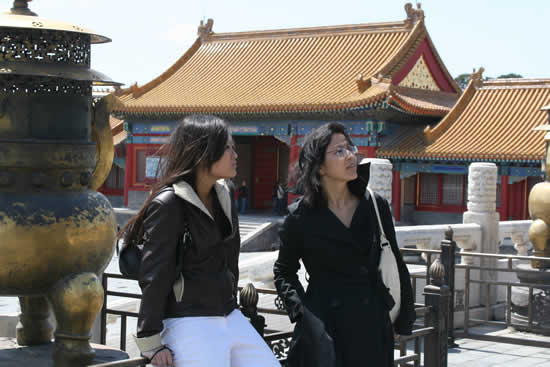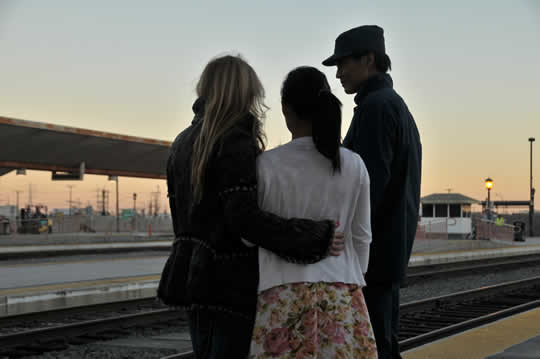 MULBERRY CHILD is based on Jian Ping’s book Mulberry Child: A Memoir of China, the history of her coming-of-age under the brutality of Mao’s repressive Cultural Revolution. Told with the help of never-before-seen film footage inside the Cultural Revolution, MULBERRY CHILD, more than a journal of individual survival and family principles, is a lucid account of a dramatic period in China’s history.
MULBERRY CHILD is based on Jian Ping’s book Mulberry Child: A Memoir of China, the history of her coming-of-age under the brutality of Mao’s repressive Cultural Revolution. Told with the help of never-before-seen film footage inside the Cultural Revolution, MULBERRY CHILD, more than a journal of individual survival and family principles, is a lucid account of a dramatic period in China’s history.
Susan Morgan Cooper was inspired to make her first documentary Mirjana… One Girl’s Journey, about a young Croatian girl displaced by The Balkan War. Her last documentary, the award winning An Unlikely Weapon was the story of photographer Eddie Adams who won a Pulitzer for his iconic shot, The Saigon Execution, credited with helping end the Vietnam War. With Mulberry Child she filmed in both the U.S. and China tracing the legacy of Mao’s Cultural Revolution through three generations to the present. With Cass Warner, Susan has recently co-produced Hopper…in his own words , a documentary on Dennis Hopper. She is set to direct her first feature film, Team East L.A., based on a documentary she made ten years ago about a cop from East L.A who takes a group of troubled boys off the streets, out of gangs and turns them into a successful roller hockey team.
Susan Morgan Cooper is developing a film with Fairplay Pictures, focusing on the true story of street children in Rio de Janeiro and the Death Squads that routinely murder them. She is presently set to direct Roadrunners, a feature film based on her documentary Sergio.
Bijan Tehrani: How did you come up with the idea of making MULBERRY CHILD?
Susan Morgan Cooper: Well, what happened was my last film An Unlikely Weapon, was screened at the Palm Spring Film Festival and a British gentleman called Ellis Goodman came up to me and said I love your work and I have a book that I would like you to make into a movie. I read Jian Ping’s book which was her memoirs of her traumatic childhood in China during Mao’s Cultural Revolution. I liked it very much but I did not want to make a distant history lesson. Instead I wanted to do a personal story. It was not until I flew to Chicago to meet with Jian and her daughter Lisa that I found the hook for my story. There was an obvious emotional disconnect between Mother and daughter. I thought, if I could trace that disconnect back to The Cultural Revolution then I’d have a film. But Jian Ping only had a few faded photographs of her family during that time. I decided to do something that is frowned upon in documentary filmmaking: I decided to do a number of reenactments to bring the audience closer to the story. So it’s a hybrid of a documentary and a feature film.Jian and her daughter Lisa worked hard on this film to expose their emotions. their reward is that many mothers and daughters have tearfully thanked them for being so honest.
BT: How much research did you do before shooting?
SMC: At the time my daughter was attending the Art Center College of Design and her professor Wang Shouzhi, who had actually been a Red Guard during the Cultural Revolution gave me quite a bit of background on it.
BT: How did you go about casting MULBERRY CHILD?
SMC: That was a funny story. I didn’t want to have any Hollywood actors, because they would seem too slick, so my assistant and I would drive around Chinatown and I would jump out of a moving car and chase little old ladies down the street looking for the grandma. I basically had to find someone with no teeth. Then I would hang out at the LA unified school district in the playgrounds like some kind of predator looking for the Chinese children. I had a favorite Chinese restaurant called the Palace in Hollywood and one day I went to the owner and said, “Tony I need 6 Red Guards”. He opened the door to his kitchen, pointed to the dishwashers and said, “Susan, choose”. It was a very unorthodox casting process. The man who plays the father in my film, Bruce Yong is a chiropractor in Santa Barbara and Christine Chiang who plays the mother is actually a newscaster on Chinese television between 6 & 7 every night.
BT: How did you go about working with the actors?
SMC: The 80 year old woman was quite frail and spoke only Mandarin, no English at all. When her daughter, Helen, would come to the set with her, I would say, “Helen I need your mother to lie quietly as if she is very weak. It was two seconds of explanation on my part and then Helen would go on and on in Mandarin and I would have no idea what she was saying and then the woman would do exactly as I wanted. I would tell everyone that she is as good as Helen Mirren, even though she has never acted before in her entire life.
 BT: How did you come up with the visual style of MULBERRY CHILD?
BT: How did you come up with the visual style of MULBERRY CHILD?
SMC: I worked with my amazing cinematographer, Quyen Tran, who was highly recommended to me by White House press photographer, David Kennerly. We worked together and sort of planned out the shots and the style. I wanted the reenactments to look very simple and primitive. We went to film in China with my two subjects, the mother and the daughter who were Chinese and Quyen who is Vietnamese and my own daughter Alexandra Cooper who was the still photographer. The five of us, all women, filmed in China under the radar using a Canon 5D ,which looks like a still camera, but we were actually shooting video. I didn’t want to apply formally to film there because I would have been assigned someone who would have monitored everything I did. Because I was dealing with the Cultural Revolution it’s a taboo subject. It is a dark period of history, which the Chinese are not ready to face. We filmed in the South of China in Shantou where they have a Cultural Revolution museum that receives no visitors at all. Then we shot in the very northeast near the Russian border. After a great deal of traveling we found a mud hut that duplicated the hut that the family was banished to. I scraped some mud off the wall in the village, put it in a plastic bag in my suitcase and brought it back to the US. With a workman I took earth, lime and straw to match the mud and constructed a hut on my property. There we could film using regular Chinese people to do the reenactments.
There are photographs in this film taken by Li Zhensheng, a photographer who had joined the Red Guard and was paid by Mao Tse Tung to take propaganda photographs. Instead he risked his life documenting the torment and the chaos. Many of the negatives of the photographs in this film he had hidden for 35 years under the floorboards before they could be published.
BT: How important is this film in terms of telling this story to people in China and other parts of the world.
SMC: There are parts of the world where people are striving for democracy but are under the oppression of dictatorship. Someone asked me the other night what I have taken away from dealing with the Cultural Revolution. I said that we are very lucky to live in this country because we have freedom of speech, our children can say exactly what they feel at any time, they don’t have to hide or lie or walk around in fear of the government. We don’t appreciate how lucky we are to live in a free society. It was strange because the Chinese people themselves are so lovely and very much pro-American. They are fascinated by anything that is going on here and they have respect for the Western World. Nothing prepared me for how kind and generous they were to us. One day in our travels in the middle of nowhere we went into this tiny Hunan restaurant. There were posters of Mao everywhere on the walls. I told the owner how much I loved them. In two seconds she went into the kitchen and returned with about ten rolled up posters of Mao. She said. “Please take as many as you like.”
I want to add how important, in a film like this is of course the editing. Sean Valla[Hurt Locker]and Miranda Yousef [Troubadours] did a great job. The sound and the music are so important. My sound editor, Mark Stoeckinger went to China to foley the sound of an old Chinese cart that I had rented to move the family. The music was composed by Kyle Eastwood and Matt McGuire and heightens so many moments in the movie. The opening scene where the 2008 drummers start the Olympics, is made exquisite by their music. On opening night Clint Eastwood came to the screening to support his son’s work and was very proud of it and like the audience, said he was quite moved by the film. That was a lovely moment for me.
BT: What is the next project that you are working on?
SMC: I’ve co-produced a movie with Cass Warner, the grand daughter of Harry Warner, who directed a movie about Dennis Hopper. It’s a warm and wonderful movie!
I am embarking on new territory to make a feature film, based on a documentary I made ten years ago, called Team East LA. The script is written by a man named Mark Nassar and is about a cop from east LA who takes a bunch of troubled kids off the streets and out of gangs and turns them into a successful roller hockey team. Its going to be the most heartwarming film! It is truly wonderful and it has lots of difficult stunts in it and is going to be a big challenge for me.
Many people from all over the world have seen Mulberry Child and they all talk about their own immigrant experiences and how their parents overcame great adversity to bring their children to the United States to get them a good education. I have been asked to screen in New York for a huge group of mothers who have adopted Chinese children. They want to share this movie with their children who have no idea about their Chinese roots. I am looking forward to that very much.

